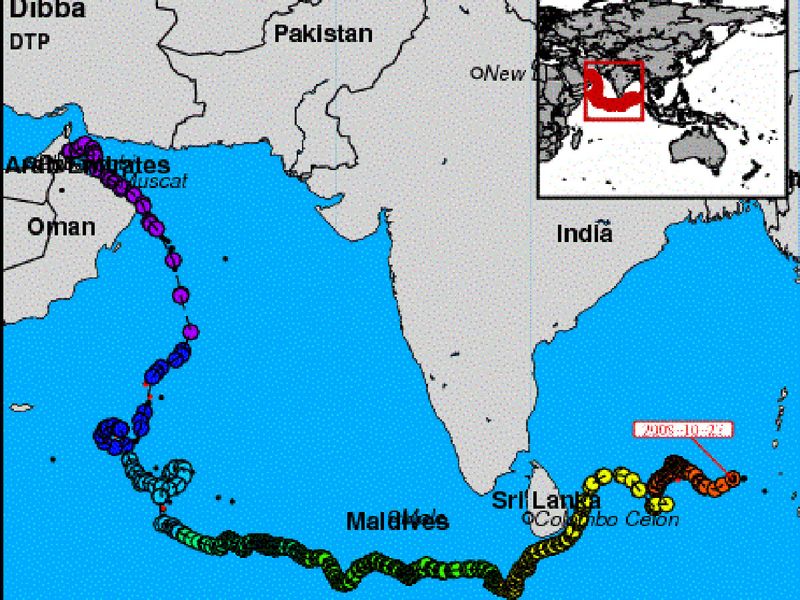
Mistaken for a rock, Dibba was miraculously rescued from the coast of the Northern Emirates by a labrador and its owner in 2006. Following this incredible rescue, Dibba was brought to the Dubai Turtle Rehabilitation Project (DTRP), where she began a new chapter of hope and healing.
In an interview with Gulf News, Barbera Lang-Lenton, the director of the Aquarium at Jumeirah's flagship property, Jumeirah Burj Al Arab, shared the incredible journey that spanned over 8,600 kilometres in nine months. "A female green sea turtle named Dibba, released from Jumeirah Beach in February 2008, voyaged the vastness of the Indian Ocean and reached the coast of Thailand in good health. She was 50 years old then; Dibba's remarkable feat is a testament to the resilience and strength of these creatures," she said.
Counting days...
Upon entering the rehabilitation program in August 2006, the turtle suffered from a severe head wound and skull fracture, it was immobile for weeks. The injury, which was not fresh, contained a significant amount of foreign matter and even algal growth. Due to further secondary infections on the carapace (the hard upper shell) and neck, intensive and prolonged treatment was required. Over many weeks of force-feeding and antibiotic administration, Dibba began to recover slowly. In December 2006, the turtle started to self-feed, prompting a transfer to an outdoor facility for continued recovery, Lang-Lenton explained.
According to data from seaturtle.org, a website dedicated to the rehabilitation and protection of turtles, Dibba spent 546 days in rehabilitation, reaching a weight of around 80 kilograms.
Discover the path ahead
"Equipped with a satellite transmitter, Dibba became a trailblazer for the Dubai Turtle Rehabilitation Project as she embarked on her extraordinary migration. After its release, Dibba was tracked for approximately 259 days before the signal was lost due to battery depletion. Studies indicate that Dibba travelled to Oman, the Maldives, Sri Lanka, India, and eventually Thailand," Lang-Lenton said.

Usually, turtles encounter multiple challenges, dodging plastic pollution, boat traffic, and fishing gear.
"Loggerheads to large green turtles face daily threats as they travel across the world's oceans. The Hawksbill turtle, native to the Middle East, is listed as critically endangered. Satellite tagging has been established for green turtles since 2005. These turtles are usually hunted for meat and eggs and have a crucial survival chance. Despite these obstacles, Dibba persevered, forging ahead on her solitary odyssey, occasionally accompanied by other migrating sea turtles," she added.
The tracking data from Dibba's journey has provided invaluable insights into the migratory patterns of sea turtles, shedding light on their ability to travel vast distances and adapt to different environments.
How are the turtles tracked?
Satellite tracking involves attaching a special piece of tracking equipment called a Platform Terminal Transmitter ( PTT) to a sea turtle's carapace (shell). It sends a message to a satellite each time the turtle comes to the surface to breathe, thus creating a map of their migration, diving behaviour, foraging grounds, and their preferred water temperature.
"Currently, through this tracking program, we monitor around 92 turtles with satellite transmitters; researchers have gained a deeper understanding of the wider migratory patterns of sea turtles, aiding conservation efforts and highlighting the importance of preserving nesting beaches in locations such as India and the Gulf region," Lang-Lenton said.

Satellite tagging has been established for green turtles since 2005. These turtles are usually hunted for meat and eggs and have a crucial survival chance.
Why did Dibba travel to Thailand?
"She must have been born in Thailand or somewhere nearby, and that's why she chose to return. Dibba is the only turtle in our rehab project that has travelled this far. Sea turtles are believed to use the Earth's magnetic field and ocean currents to navigate. There may be several reasons for their travel. Their nesting occurs between mid-March and mid-June, with more than 200 nests typically reported during the season. The Gulf region is one of their nesting habitats. Other possible reasons for this behaviour include migration and searching for food or a mate."
The Dubai Turtle Rehabilitation Project faces challenges, including high tracking costs and the need to monitor juvenile turtles for months. Tracking Dibba's journey has provided crucial data and inspired appreciation for sea turtles' resilience. The public brings in most turtles after being found washed up on the shore, often with injuries from plastic or heavy barnacle growth on their shells. To help sick or injured turtles get the care they need quickly, the project has set up a special phone line: 800 TURTLE. You can call this number to report a turtle in distress.












